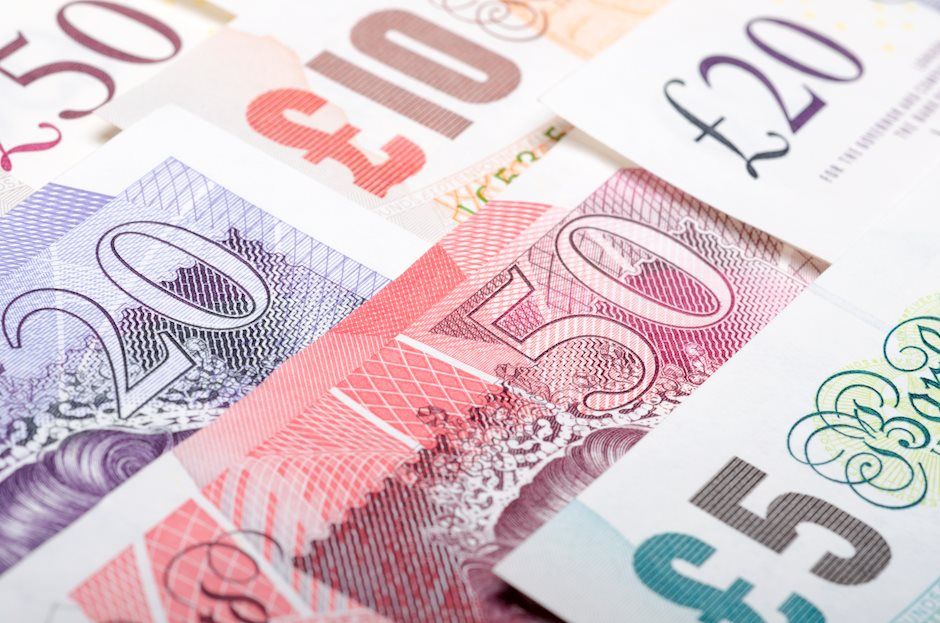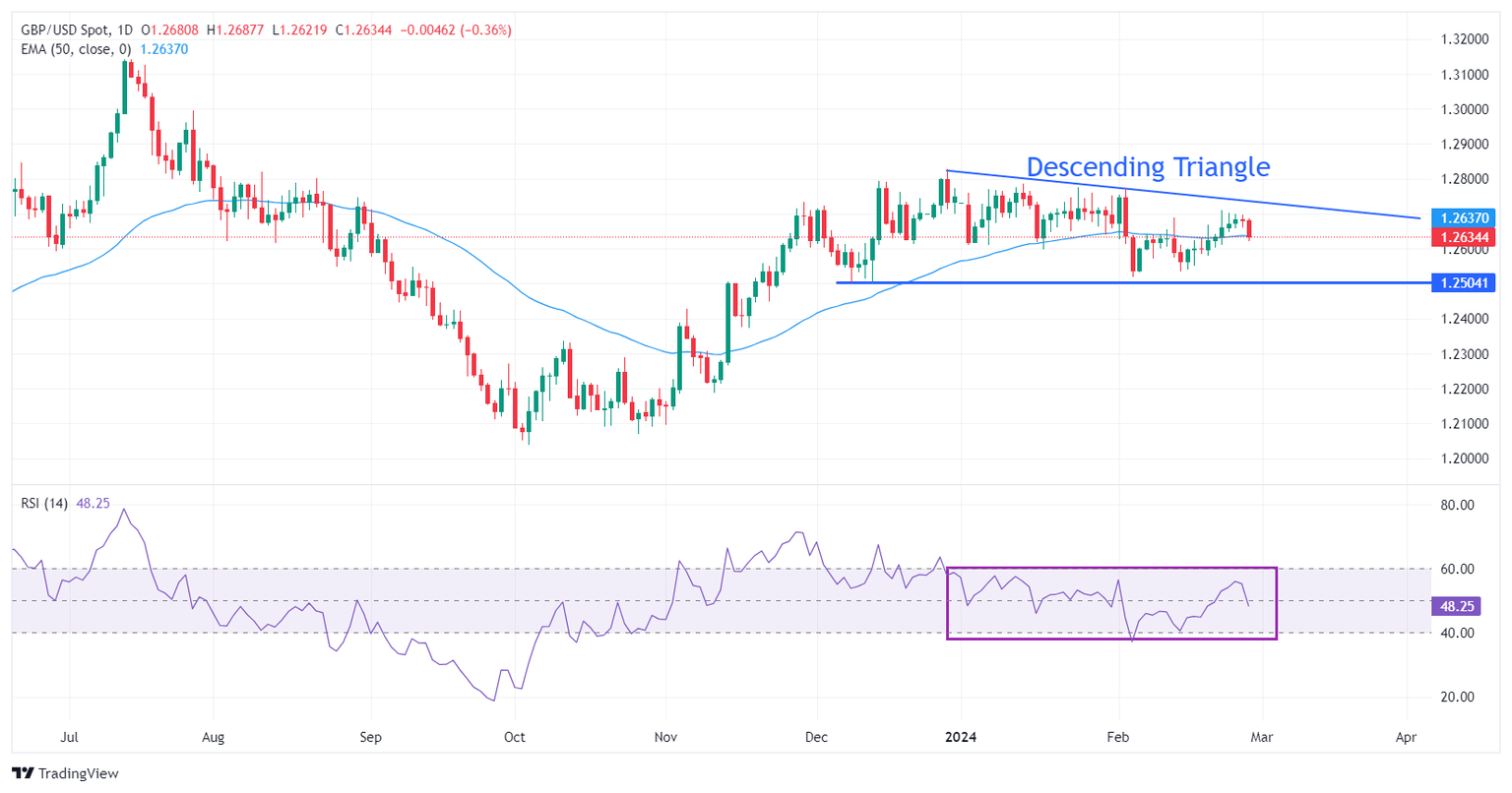Pound Sterling plummets on risk-off mood ahead of US inflation data
- Pound Sterling faces a sharp sell-off as market sentiment turns volatile.
- BoE Ramsden wants to see how long price pressures will remain sticky.
- The US Dollar rises ahead of US core PCE price index data.

The Pound Sterling (GBP) weakens in Wednesday’s late European session as the market sentiment remains volatile ahead of critical United States core Personal Consumption Expenditure price index (PCE) data for January. The GBP/USD pair falls on the back foot despite expectations that the Bank of England (BoE) will begin reducing interest rates later than the Federal Reserve (Fed). This supports the Pound Sterling as higher interest rates generally attract greater foreign capital inflows.
Investors see the BoE considering a change in monetary policy stance later than other central banks as price pressures in the United Kingdom economy are stubborn due to high wage growth – a plus for Sterling. BoE policymakers have warned that the pace at which Average Earnings are decelerating is half of what is required to achieve price stability.
Going ahead, the Pound Sterling will be guided by market expectations for rate cuts by the BoE. Stock investors hope that the BoE will start reducing interest rates from August as this will support the wider stock market. This might be the time when inflation flares up again after declining to 2%, as projected by the BoE, revealed in the latest monetary policy statement.
Daily Digest Market Movers: Pound Sterling slumps on dismal market mood
- Pound Sterling falls sharply after failing to recapture the round-level resistance of 1.2700 amid a cautious market mood.
- Investors are holding to the sidelines ahead of the crucial United States core PCE price index data for January, which will be published on Thursday.
- This crucial inflation data will provide more cues on when the Federal Reserve (Fed) could begin reducing interest rates.
- Projections from market participants show that the underlying inflation data decelerated to 2.8% from 2.9% in December on a year-on-year basis.
- The US Dollar Index (DXY), which values the Greenback against six major currencies, rises to the crucial resistance of 104.00.
- On the domestic front, the Pound Sterling will be guided by market expectations for rate cuts by the Bank of England.
- BoE policymakers are less interested in lowering key lending rates currently as they need more evidence that inflation will come down to the 2% target.
- On Tuesday, BoE Deputy Governor Dave Ramsden, who voted for holding interest rates at 5.25% in the last monetary policy meeting, said he wants to see how long inflation will remain persistent.
- Dave Ramsden added the duration of inflation remaining persistent will determine how long interest rates will be maintained at 5.25%.
- Price pressures in the United Kingdom economy are stubborn due to higher wage growth and service inflation.
- These key inflation indicators have come down sharply, but the pace of decline is still inconsistent, with inflation declining towards the 2% target.
Technical Analysis: Pound Sterling faces sell-off near 1.2700
Pound Sterling drops sharply after facing stiff resistance near 1.2700. The GBP/USD pair is consistently facing barricades near the downward-sloping border of the Descending Triangle pattern formed on a daily time frame, with the upper border line traced from the December 28 high at 1.2827. The triangle’s horizontal support is plotted from December 13 low near 1.2500.
A Descending Triangle pattern demonstrates indecisiveness among market participants but with a slight downside bias due to lower highs and flat lows formation.
The pair declines toward the 20 and 50-day Exponential Moving Averages (EMAs), which trade around 1.2630. Meanwhile, the 14-period Relative Strength Index (RSI) remains inside the 40.00-60.00 region, which indicates a sharp contraction in volatility.
BoE FAQs
What does the Bank of England do and how does it impact the Pound?
The Bank of England (BoE) decides monetary policy for the United Kingdom. Its primary goal is to achieve ‘price stability’, or a steady inflation rate of 2%. Its tool for achieving this is via the adjustment of base lending rates. The BoE sets the rate at which it lends to commercial banks and banks lend to each other, determining the level of interest rates in the economy overall. This also impacts the value of the Pound Sterling (GBP).
How does the Bank of England’s monetary policy influence Sterling?
When inflation is above the Bank of England’s target it responds by raising interest rates, making it more expensive for people and businesses to access credit. This is positive for the Pound Sterling because higher interest rates make the UK a more attractive place for global investors to park their money. When inflation falls below target, it is a sign economic growth is slowing, and the BoE will consider lowering interest rates to cheapen credit in the hope businesses will borrow to invest in growth-generating projects – a negative for the Pound Sterling.
What is Quantitative Easing (QE) and how does it affect the Pound?
In extreme situations, the Bank of England can enact a policy called Quantitative Easing (QE). QE is the process by which the BoE substantially increases the flow of credit in a stuck financial system. QE is a last resort policy when lowering interest rates will not achieve the necessary result. The process of QE involves the BoE printing money to buy assets – usually government or AAA-rated corporate bonds – from banks and other financial institutions. QE usually results in a weaker Pound Sterling.
What is Quantitative tightening (QT) and how does it affect the Pound Sterling?
Quantitative tightening (QT) is the reverse of QE, enacted when the economy is strengthening and inflation starts rising. Whilst in QE the Bank of England (BoE) purchases government and corporate bonds from financial institutions to encourage them to lend; in QT, the BoE stops buying more bonds, and stops reinvesting the principal maturing on the bonds it already holds. It is usually positive for the Pound Sterling.
Author

Sagar Dua
FXStreet
Sagar Dua is associated with the financial markets from his college days. Along with pursuing post-graduation in Commerce in 2014, he started his markets training with chart analysis.


















